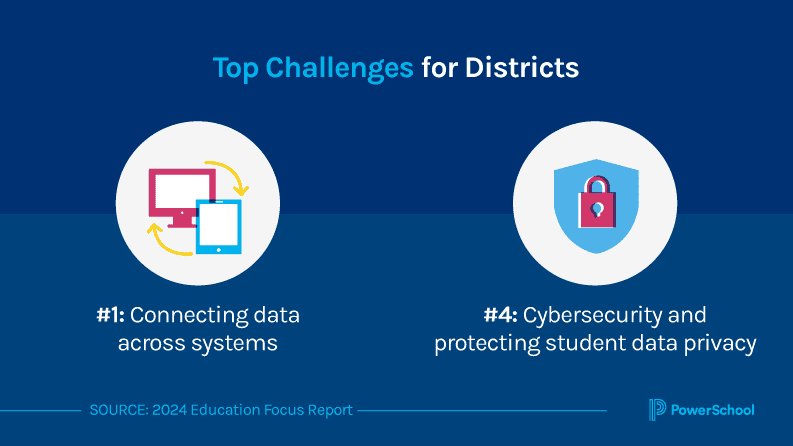Run efficiently with a small team with user-friendly edtech products that deliver data insights, streamline tasks, and time and cost savings
Smaller teams at schools and districts often face big challenges—like limited resources and unlimited job responsibilities. In smaller teams, you typically wear many hats and fill a variety of roles. So, when you’re also stuck using inefficient or disparate software products, your challenges are compounded even further.
Without products that connect, share data, and offer a familiar, easy user experience, you are likely experiencing:
- Reduced ability to see the whole child, including grades, test scores, attendance, and behavior
- Wasted time navigating multiple products or on simple tasks with varying user experiences and processes
- Lack of simple access to data insights and inability to meet the needs of every student
Plus, with a smaller team, you may be experiencing more risk of cybersecurity threats and attacks with fewer dedicated staff, resources, and budget to devote to data security.
Choosing modern, interoperable technology decreases your cost of ownership, improves efficiency, improves cybersecurity, and helps you serve students better.
The Problem Smaller Teams Face with Too Many Tools
Schools and districts are using too many tools that don’t connect with each other. As proof, 65% of districts say that a lack of interoperability is a widespread problem for them. And in general, 32 days every year are wasted navigating between different software products with 69% of workers wasting up to an hour a day.
A report by McKinsey & Company determined that by using technology, up to 30% more time in a teacher’s day could be spent could supporting student learning.
And in smaller teams, you just don’t have the resources to manage that many disparate tech products when you’re already burdened with multiple roles and responsibilities.
- 46% of educators say juggling multiple digital tools for teaching and learning is a top edtech challenge
- 32 days/year are wasted navigating between apps
- 69% of workers waste up to 60 minutes daily
- 68% toggle between apps up to 10 times/hour
- 20-30% of teachers’ time could be reallocated through technology toward activities that support learning
Benefits of Efficient, Interoperable Edtech for Smaller Teams
Smaller teams can reap significant benefits in terms of efficiency and productivity when using integrated software products that provide a seamless “one-stop shop” ecosystem experience. In this scenario, it’s like you are using one product for a variety of functions rather than juggling different platforms or interfaces.
In a national survey, workers say a unified, or integrated, platform helps them achieve a better workflow (67%), gain more productivity (65%), and help work feel less chaotic (64%).
“Interoperability involves multiple systems sharing a language or a framework for language that’s designed to help them function together as a whole to improve usability and/or security … Interoperability is synchrony,” say authors by Douglas Konopelko and Time Clark in EdTech Magazine’s “Empowering Teaching and Learning with Interoperability.”
Additional benefits of modern, interoperable edtech products include:
- Improved data integrity and security
- Saved administrative and instructional time with simpler workflow
- Increased ROI on edtech products
- Accelerated digital transformation initiatives
- Easier to access and use data
- Better adoption and use of new technology
With products and data in multiple locations, it takes more time for educators to see comprehensive insights. Visibility into whole-child analytics is difficult with a system cluttered with fragmented products.
But interoperability makes it easier to access and use data in the classroom, within schools, and the entire district. When products connect and share student data, teachers and administrators save time when they can access accurate, updated information from unified sources.
As an example of a district seeing benefits by using integrated edtech products that connect and share data, Virginia’s Fredericksburg City Public Schools is using PowerSchool SIS and PowerSchool Student Analytics to gain real-time data insights into student progress and trends. The district’s IT staff can pull accurate data in minutes, compared to the hours it had been taking them when using siloed spreadsheets and pivot tables.
Another example of modern edtech products working together is the PowerSchool Talent Recruitment & Retention Cloud, featuring integrated technology to recruit top-tier talent, make hiring processes easier, and transform real-time instructional coaching data into personalized goals and PD recommendations. This solution set features products that work together to streamline the entire process, including an online job board, applicant tracking, candidate assessment, and employee records.
Washington’s West Valley School District has implemented an integrated HR ecosystem, bringing together products for applicant tracking, employee records, teacher evaluations, and professional learning. As a result, they’re benefitting from:
- Streamlined digital workflows
- Smoother and more efficient onboarding experience for new hires
- Improved inter-departmental communication
- Greater access and visibility into hiring and funding for all stakeholders
- Refined consistency and equity for teacher evaluations
How to Create an Interoperable, Efficient Edtech Ecosystem
If your school district is struggling with too many tools and disjointed systems, now is the time to start building an interoperable edtech ecosystem. Here’s are steps to take:
- Review Operations for Redundancies—Audit your current software to identify tools that overlap in function or aren’t being fully utilized.
- Research Edtech Vendors—Look for companies prioritizing interoperability. Ask about how their products integrate with your existing tools and systems. Start with resources like this infographic on choosing a data analytics vendor. You can also utilize ROI calculators that let you enter your district metrics and see costs and potential savings.
- Adopt Interoperability Standards – Choose platforms that follow industry standards for secure and consistent data transmission. This ensures smooth connections between products and helps prevent data silos.
- Plan for Growth – As your school or district expands its edtech, continue to prioritize tools that connect seamlessly, ensuring that your tech ecosystem grows in a way that’s sustainable and secure.
Run Efficiently with a Small Team
Learn more about managing administrative tasks with secure, intuitive technology that gives y9ou time back.
Visit the Resource Page



